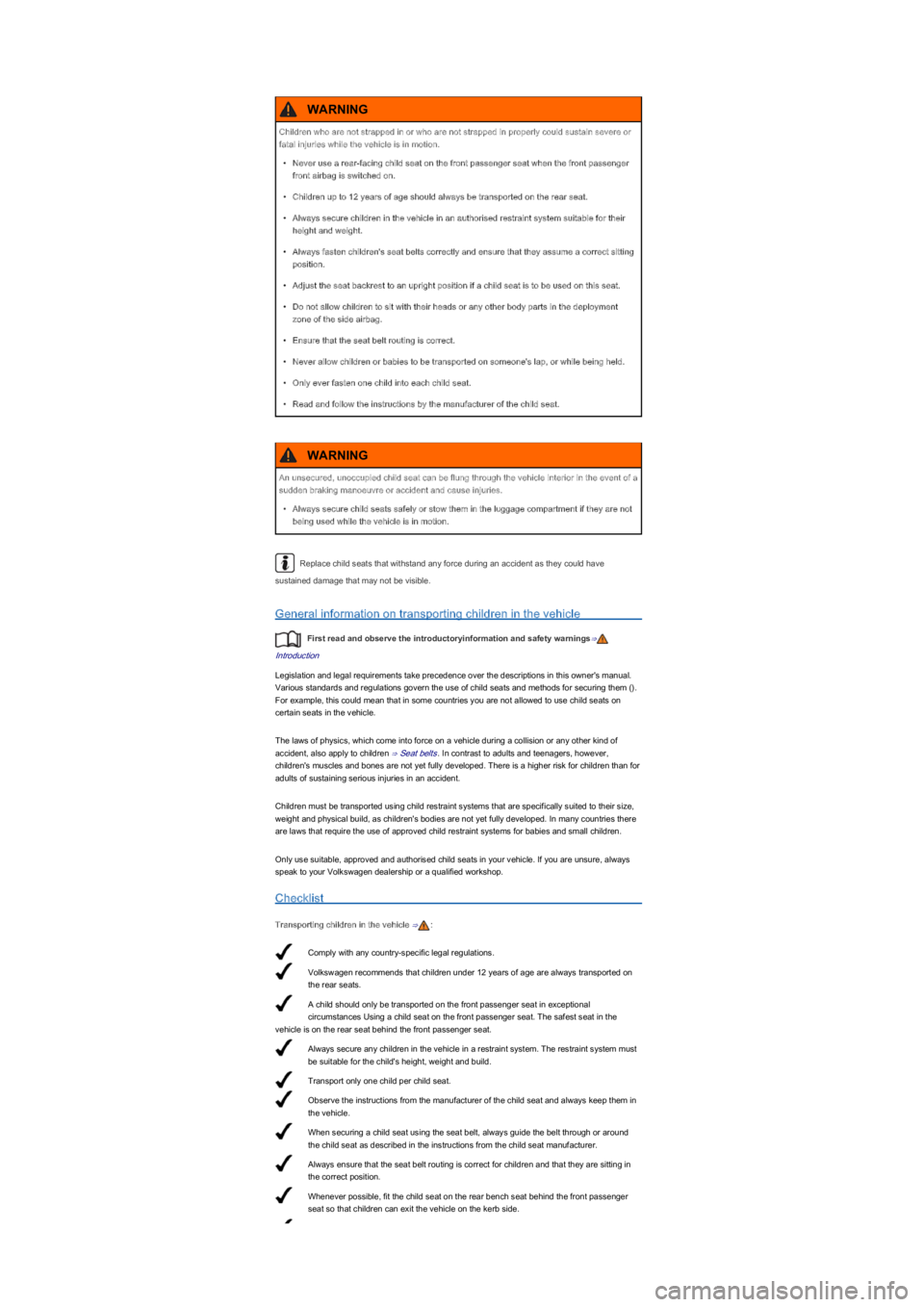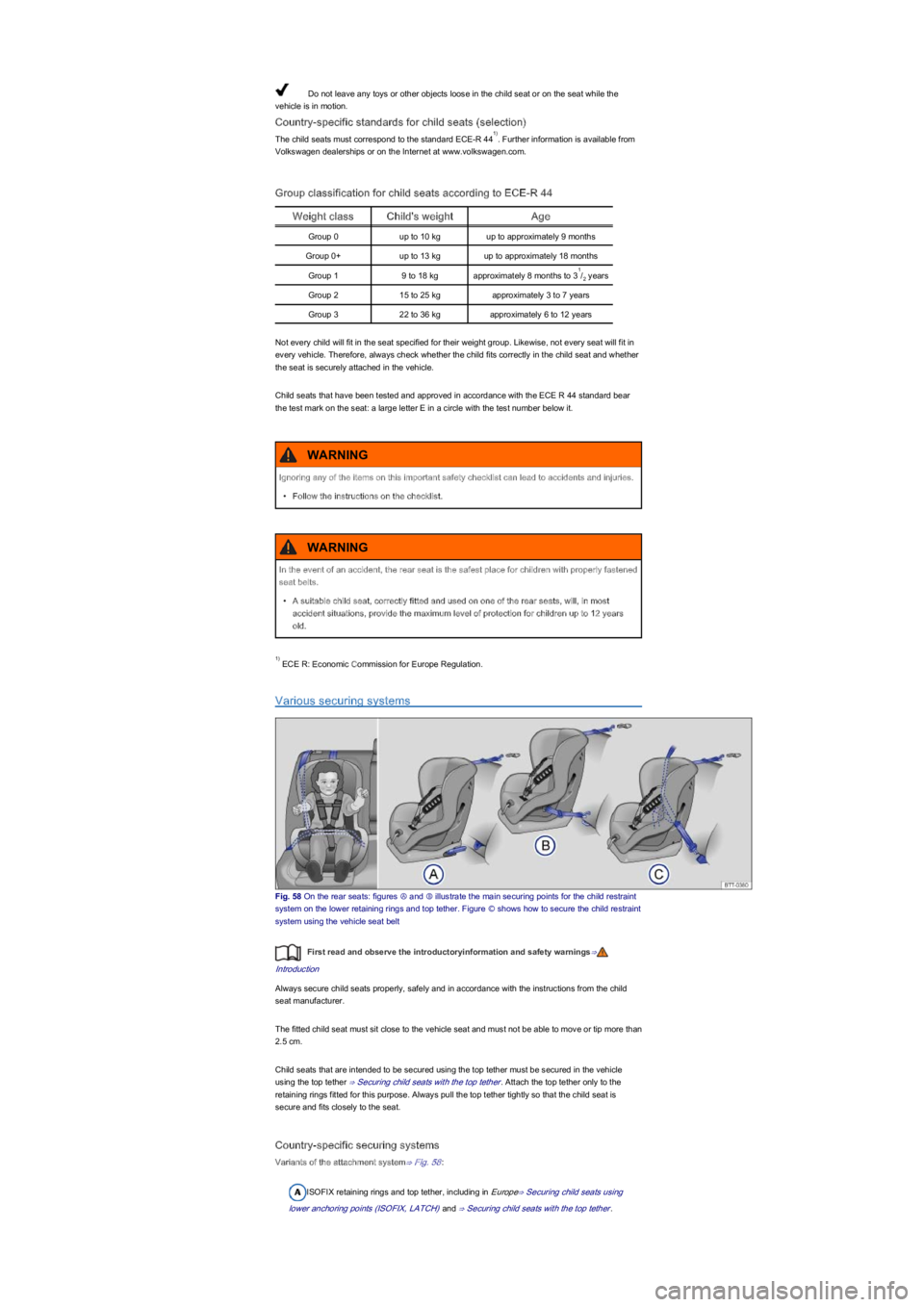Page 54 of 211

Comply with any country-specific legal regulations.
Volkswagen recommends that children under 12 years of age are always transported on
the rear seats.
A child should only be transported on the front passenger seat in exceptional
circumstances Using a child seat on the front passenger seat. The safest seat in the
vehicle is on the rear seat behind the front passenger seat.
Always secure any children in the vehicle in a restraint system. The restraint system must
be suitable for the child's height, weight and build.
Transport only one child per child seat.
Observe the instructions from the manufacturer of the child seat and always keep them in
the vehicle.
When securing a child seat using the seat belt, always guide the belt through or around
the child seat as described in the instructions from the child seat manufacturer.
Always ensure that the seat belt routing is correct for children and that they are sitting in
the correct position.
Whenever possible, fit the child seat on the rear bench seat behind the front passenger
seat so that children can exit the vehicle on the kerb side.
Replace child seats that withstand any force during an accident as they could have
sustained damage that may not be visible.
General information on transporting children in the vehicle
First read and observe the introductoryinformation and safety warnings⇒
Introduction
Legislation and legal requirements take precedence over the descriptions in this owner's manual.
Various standards and regulations govern the use of child seats and methods for securing them (yf���
For example, this could mean that in some countries you are not allowed to use child seats on
certain seats in the vehicle.
The laws of physics, which come into force on a vehicle during a collision or any other kind of
accident, also apply to children ⇒ Seat belts. In contrast to adults and teenagers, however,
children's muscles and bones are not yet fully developed. There is a higher risk for children than for
adults of sustaining serious injuries in an accident.
Children must be transported using child restraint systems that are specifically suited to their size,
weight and physical build, as children's bodies are not yet fully developed. In many countries there
are laws that require the use of approved child restraint systems for babies and small children.
Only use suitable, approved and authorised child seats in your vehicle. If you are unsure, always
speak to your Volkswagen dealership or a qualified workshop.
Checklist
Transporting children in the vehicle ⇒:
Children who are not strapped in or who are not strapped in properly could sustain severe or
fatal injuries while the vehicle is in motion.
\f
Page 55 of 211

Do not leave any toys or other objects loose in the child seat or on the seat while the
vehicle is in motion.
Country-specific standards for child seats (selectionyf
The child seats must correspond to the standard ECE-R 44. Further information is available from
Volkswagen dealerships or on the Internet at www.volkswagen.com.
Group classification for child seats according to ECE-R 44
Weight classChild's weightAge
Group 0up to 10 kgup to approximately 9 months
Group 0+up to 13 kgup to approximately 18 months
Group 19 to 18 kgapproximately 8 months to 3/ years
Group 215 to 25 kgapproximately 3 to 7 years
Group 322 to 36 kgapproximately 6 to 12 years
Not every child will fit in the seat specified for their weight group. Likewise, not every seat will fit in
every vehicle. Therefore, always check whether the child fits correctly in the child seat and whether
the seat is securely attached in the vehicle.
Child seats that have been tested and approved in accordance with the ECE R 44 standard bear
the test mark on the seat: a large letter E in a circle with the test number below it.
ECE R: Economic Commission for Europe Regulation.
Various securing systems
Fig. 58 On the rear seats: figures Ⓐ and Ⓑ illustrate the main securing points for the child restraint
system on the lower retaining rings and top tether. Figure Ⓒ shows how to secure the child restraint
system using the vehicle seat belt
First read and observe the introductoryinformation and safety warnings⇒
Introduction
Always secure child seats properly, safely and in accordance with the instructions from the child
seat manufacturer.
The fitted child seat must sit close to the vehicle seat and must not be able to move or tip more than
2.5 cm.
Child seats that are intended to be secured using the top tether must be secured in the vehicle
using the top tether ⇒ Securing child seats with the top tether. Attach the top tether only to the
retaining rings fitted for this purpose. Always pull the top tether tightly so that the child seat is
secure and fits closely to the seat.
Country-specific securing systems
Variants of the attachment system⇒ Fig. 58:
ISOFIX retaining rings and top tether, including in Europe⇒ Securing child seats using
lower anchoring points (ISOFIX, LATCHyf and ⇒ Securing child seats with the top tether.
1yf
1
2
Ignoring any of the items on this important safety checklist can lead to accidents and injuries.
\f
Page 56 of 211

LATCH/UCRA universal anchorage attachment points and top tether, including in North
America⇒ Securing child seats using lower anchoring points (ISOFIX, LATCHyf.
Three-point automatic seat belt and top tether⇒ Securing child seats with a seat belt.
The systems consist of attachments for child restraint systems with a top tether and lower
anchoring points in the seat.
Using a child seat on the front passenger seat
First read and observe the introductoryinformation and safety warnings⇒
Introduction
Not all countries allow you to transport children on the front passenger seat. Not every child seat is
suitable for use on the front passenger seat. Volkswagen dealerships keep an up-to-date list of all
authorised child seats. Only use child seats that have been authorised for your vehicle.
The active front airbag on the front passenger side presents a major danger to a child. Transporting
a child in a rear-facing child seat on the front passenger seat can pose a danger to the child's life.
If a rear-facing child seat is secured to the front passenger seat, an inflating front passenger front
airbag can strike it with such force that critical or fatal injuries may occur ⇒. Therefore, never
use a rear-facing child seat on the front passenger seat when the front passenger front airbag is
activated.
Only use a rear-facing child seat on the front passenger seat when you have ascertained that the
front passenger front airbag has been switched off. This is confirmed when the yellow indicator
lamp in the dash panel PASSENGER AIR BAG lights up ⇒ Airbag system. If the front
passenger front airbag cannot be switched off and stays active, do not transport any children on
the front passenger seat⇒.
What to be aware of when using a child seat on the front passenger seat:
\f
Page 57 of 211
Ensure that the front passenger can still maintain a correct sitting position ⇒ Adjusting the seat
position.
Suitable child seats
The child seat must have been approved by the manufacturer for use on the rear bench seat with
side airbag.
Universal child seats in groups 0, 0+, 1, 2, or 3 as specified in ECE-R 44 can be fitted to the rear
seats.
The seats are suitable for child seats with the ISOFIX system that are specially approved for this
vehicle type by ECE-R 44.
ISOFIX child seats approved for use on rear seats
There are different categories of ISOFIX child seats: universal, semi-universal and vehicle-specific.
\f
Page 58 of 211
Removing child seats
Unfasten seat belts only when the vehicle is stationary ⇒.
\f
Page 82 of 211
Open stowage compartment on the front passenger side
Fig. 84 Open stowage compartment on front passenger side
First read and observe the introductoryinformation and safety warnings⇒
Introduction
There may be an open stowage compartment located on the front passenger side.
Holder
A bag hook is located at the open stowage compartment ⇒ Fig. 84①.
Stowage compartment in the rear centre console
Fig. 85 In the rear centre console: stowage compartment
First read and observe the introductoryinformation and safety warnings⇒
Introduction
The drink holder in the rear centre console ⇒ Drink holder can be used as a stowage area.
Other stowage areas
Fig. 86 In front of the rear seats: stowage compartment in 2-door vehicles
Loose objects may be flung through the vehicle interior in the event of a sudden driving or
braking manoeuvre. This can cause serious injury and can also lead to loss of control of the
vehicle.
\f
Page 99 of 211

Lit upPossible cause ⇒Solution
In conjunction with warning lamp :
ABS and EBV not functioning.
Do not drive on!
Seek expert assistance immediately ⇒ Fault
in the brake system.
Brake pedal not depressed.To select a position, press the brake pedal.
FlashesPossible causeSolution
ESC/TCS is taking corrective action.Remove foot from accelerator pedal. Adapt
driving style to suit road conditions.
Traction Control active.
Remove foot from accelerator pedal. Adapt
driving style to suit road conditions
⇒ Traction Control System (TCSyf���R�U�
Traction Control (TCyf.
Flashing: vehicle with an automated
manual gearbox is not secured from
rolling away.
Apply the handbrake.
Several warning and indicator lamps will light up briefly as a functional check when the ignition is
switched on. They will switch off after a few seconds.
Handbrake
Fig. 100 Handbrake between the front seats
First read and observe the introductoryinformation and safety warnings⇒
Introduction
Applying the handbrake
\f
Page 153 of 211
Before getting into the vehicle, close all Velcro fasteners that could touch the cloth seat
covers and fabric trims. Open Velcro fasteners can cause damage to cloth seat covers and
fabric trims.
Avoid the direct contact of sharp-edged items and accessories to the upholstery and fabric
trims in order to prevent damage. Accessories include zips, studs, rhinestones on clothing
or belts.
Dust and grit in upholstery pores, folds and seams should be removed regularly so that no
permanent damage is caused to the surface of the seats by scratching.
Always check whether garments are colourfast to prevent damage to the upholstery. This
is especially important for light-coloured upholstery.
\f